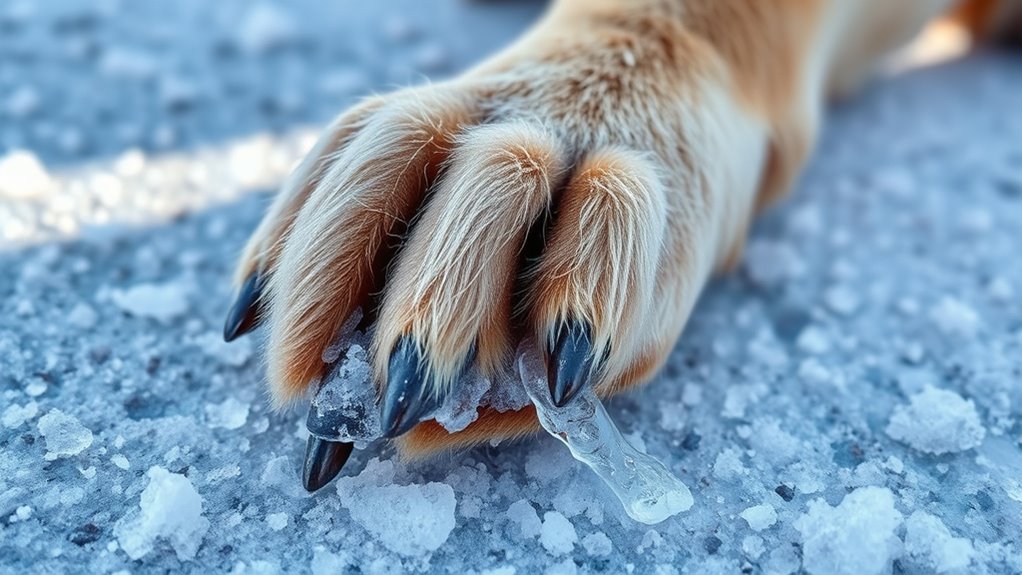During winter, safeguard your pet’s paws from cold, ice, and chemical deicers by using waterproof boots and paw balms. Always wipe off ice melt residue and chemicals after outdoor walks to prevent irritation or ingestion. Trim nails and check paw pads regularly for cracks or dryness. Be aware of ice melt hazards, opting for pet-safe products when possible. To make certain your pet stays comfortable and healthy, learn simple tips to care for their paws in winter.
Key Takeaways
- Use pet-safe, insulated boots to protect paws from cold, ice, and rough surfaces during winter walks.
- Always wipe paws thoroughly after outdoor outings to remove ice melt, chemicals, and debris.
- Regularly inspect paw pads for cracks, dryness, or peeling, and apply paw balm as needed.
- Trim nails to prevent snow buildup and improve traction on icy surfaces.
- Avoid human lotions; instead, use pet-specific paw wax or balm to moisturize and shield paws from hazards.

As temperatures drop, your pet’s paws face increased risks from cold, ice, and harsh surfaces. Winter paw protection becomes essential to keep your furry friend safe and comfortable outdoors. When heading outside, consider investing in outdoor footwear designed specifically for pets. These boots shield paws from freezing temperatures, sharp ice, and rough terrain, reducing the chance of cuts, bruises, or frostbite. Proper outdoor footwear ensures your dog can enjoy walks without discomfort or injury, especially in snowy or icy conditions.
Before venturing out, inspect the ground carefully. Salt, ice melt, and chemical deicers are common in winter but can harm your pet’s paws. Many ice melts contain chemicals that cause irritation or even poisoning if ingested, so it’s crucial to prevent your pet from licking their paws after walks. Using pet-safe ice melt products can minimize these hazards, but even then, residual chemicals can stick to paws. That’s where winter paw protection with quality paw wax or booties makes a big difference. These products create a barrier that prevents harmful substances from contacting the skin and pads.
After walks, always wipe your pet’s paws thoroughly. Use a damp cloth or pet-safe wipes to remove any ice melt residue, chemicals, or debris. Regular checks are vital because ice buildup can cause cracking or peeling of the paw pads. If you notice dryness or cracking, apply a pet-safe paw balm to provide extra moisture and healing. Avoid using human lotions or petroleum-based products, which can be harmful if ingested or cause irritation. Maintaining healthy paw pads is essential for overall paw health and comfort.
Another aspect of winter paw care involves keeping your pet’s nails trimmed. Long nails can trap snow and ice, leading to discomfort or even injury when walking. Shorter nails also improve traction on icy surfaces, reducing the risk of slipping. When choosing outdoor footwear, look for options that fit snugly but comfortably, allowing your pet to walk naturally without slipping out. Ensure the boots are waterproof and insulated, offering warmth and dryness even in heavy snow or slush.
Lastly, plan your outdoor activities carefully. Limit time outside during extreme cold snaps and pick routes with cleared or less icy paths. Remember, even with the best winter paw protection, your pet’s tolerance to cold varies. Keep a close eye on their behavior—shivering, lifting paws, or reluctance to walk can signal discomfort. By taking these precautions, you help your pet stay safe, warm, and comfortable during winter adventures.
Frequently Asked Questions
Are There Natural Remedies to Soothe Paw Irritation From Cold Weather?
Yes, you can soothe paw irritation with natural remedies like herbal ointments and coconut oil. Apply a thin layer of herbal ointments, such as calendula or chamomile, to help reduce inflammation. Coconut oil acts as a moisturizer and forms a protective barrier, easing discomfort. Always guarantee your dog’s paws are clean before applying, and consult your vet if irritation persists or worsens. These remedies can help keep your dog’s paws comfortable and healthy.
How Often Should I Trim My Dog’s Paw Hair During Winter?
Did you know that over 60% of dog owners overlook winter fur maintenance? You should trim your dog’s paw hair every 4 to 6 weeks during winter to prevent ice build-up and ice melt exposure. Focus on paw pad trimming to keep their paws clean and healthy, especially as snow and ice can trap debris. Regular trims help maintain comfort and reduce irritation from cold weather.
Can Ice Melt Products Cause Long-Term Paw Damage?
Ice melt products can cause long-term paw damage if they contain chemicals that lead to burns or increase paw sensitivity. When your dog walks on treated surfaces, these chemicals can cause chemical burns and irritate sensitive paw pads. To protect your pet, wipe their paws after walks, use pet-safe ice melts, and regularly check for redness or cracking. This helps prevent lasting damage and keeps your dog’s paws healthy.
What Signs Indicate My Pet Has Frostbite on Paws?
When frostbite strikes, your pet’s paws will show clear signs. Look for frostbite symptoms like paw discoloration—white, gray, or bluish patches—and swelling or blistering. If you notice numbness or your pet limping, it’s a red flag. Remember, it’s better to be safe than sorry; act quickly if you see these signs. Protect your pet’s paws and avoid letting frostbite get a foothold.
Is There a Safe Way to Remove Ice Balls From Paws?
You should gently remove ice balls from your pet’s paws using pet booties to prevent further buildup. If ice is stuck, soak their paws in warm water for a few minutes, then carefully wipe away any remaining ice with paw wipes. Avoid pulling or scraping, as that can hurt your pet’s paws. Always check for signs of frostbite afterward, and consider using paw protection during cold walks.
Conclusion
As winter’s chill settles in, remember your paws are like fragile leaves in a harsh storm—delicate yet resilient. Protect them from icy dangers and melting salts, just as you would shield a precious bloom from frost. With care, your dog’s paws can endure the cold, standing strong through icy days. Think of each paw as a tiny lighthouse, guiding your furry friend safely home, no matter how icy the seas of winter might be.










